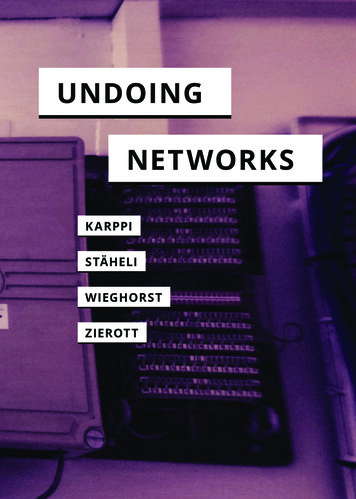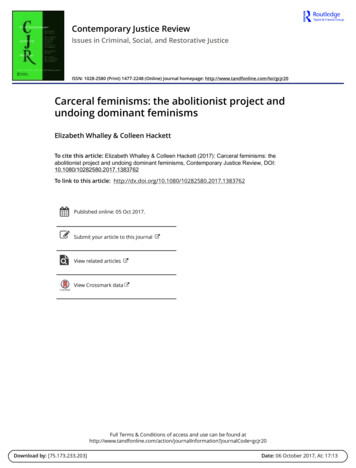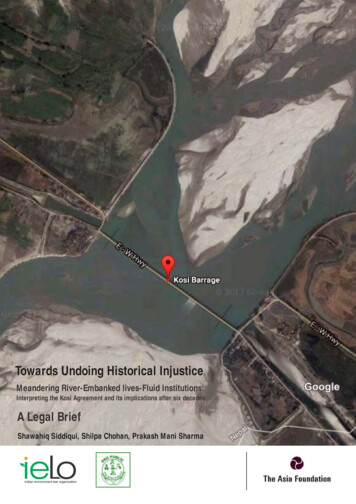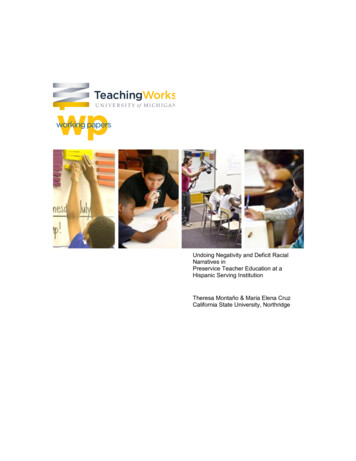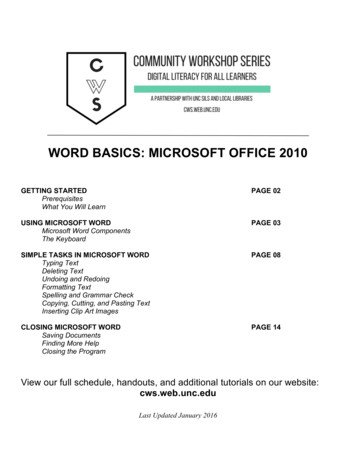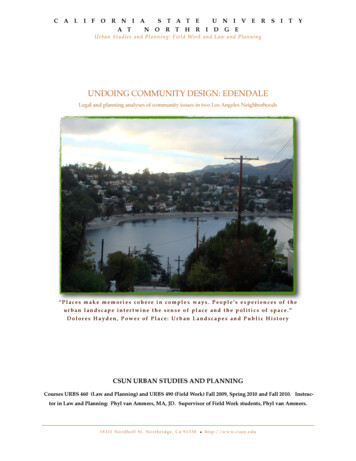
Transcription
CA L IFORN IA TANS T A T EO R T H RU N I V E RI D G ES ITYUrban Studies and Planning: Field Work and Law and PlanningUNDOING COMMUNITY DESIGN: EDENDALELegal and planning analyses of community issues in two Los Angeles Neighborhoods“Places make memories cohere in complex ways. People's experiences of theurban landscape intertwine the sense of place and the politics of space."Dolores Hayden, Power of Place: Urban Landscapes and Public HistoryCSUN URBAN STUDIES AND PLANNINGCourses URBS 460 (Law and Planning) and URBS 490 (Field Work) Fall 2009, Spring 2010 and Fall 2010. Instructor in Law and Planning: Phyl van Ammers, MA, JD. Supervisor of Field Work students, Phyl van Ammers.1 8 111 N o r d h o f f S t . N o r t h r i d g e , C a 9 1 3 3 0 h t t p : / / w w w. c s u n . e d u
Table of ContentsPreface!2Executive Summary!3History: Echo Park & Silver Lake Neighborhoods in Edendale!5Sense of Place!11Analysis of City of Los Angeles’ Anti-mural Ordinance!16Legal Analysis!21Stairs and Sustainable Development!26Sustainable development Creates Walkable Neighborhoods:!Public Stair Closure Consistency Analysis!2830Legal analysis of the City’s withdrawal of public rights-of-way in SilverLake and Echo Park!34Whitley!36Hathaway Hill!37Contributors!38Images!39L a w & P l a n n i n g C o u r s e s 4 6 0 a n d 4 9 0 : S p r i n g 2 0 1 0 a n d F a l l 2 0 1 0!1Edendale
PrefaceAnalysis by California State University Northridge Urban Studies and Planning Department students of City actions to withdraw public stairs and to create a process so that the City Art Commission may decide on the artistic merit of large murals onprivate walls before issuing a permit.Informational document prepared for the Echo Park Improvement Association and the Silver Lake Neighborhood CouncilThe Silver Lake Echo Park Elysian Heights Community Plan (“Community Plan”) emphasizes the words “links” and“linkages.”“Silver Lake and Echo Park . have a network of public staircases originally built in lieu of streets, typically because of steep terrain, to provide public access from hillside neighborhoods to main streets and the electric cars serving them. This unique network of staircases found throughout the Plan Area also potentially supplement greenwaysystems and provide linkages to existing and future open space, recreational paths and parks. As a result they shouldbe identified, maintained and, in cases where adjacent property owners closed them, reclaimed as public rights-ofway for public use. A network of stairs along the Pacific Electric Railroad Right-of-Way property leads to the propertyand could provide hillside residents with access to a future trail system that could lead to the river and Griffith Park.”Beginning in about 1980, the City Council withdrew some of these stairs from public use and allowed only the adjacent property owners or their tenants to use them. The City Council also withdrew public streets at the top of one ofthe Silver Lake hills, but it allowed then and allows now residents of the development to use those public streets. TheBureau of Engineering, which has no power delegated to it to withdraw or to vacate streets or stairways, authorizedthe withdrawal of at least one stairway – Fargo – by calling that withdrawal a “revocable permit.”The Community Plan also recognizes the neighborhoods’ public murals as distinctive features that should be preserved. The City Council, however, proposes Art Commission review of new murals as well as of some existing murals, and this review means private property owners will need permits, they will have to pay for those permits, andthe Art Commission will have the power to decide whether the larger works have artistic merit.The following analyses in this report determines that the City Council of Los Angeles has undone and is continuingto undo aspects of the Community Plan, which is the design developed by the residents of Silver Lake and Echo Park.L a w & P l a n n i n g C o u r s e s 4 6 0 a n d 4 9 0 : S p r i n g 2 0 1 0 a n d F a l l 2 0 1 0!2Edendale
Executive SummaryThis work reflects the collaborative efforts of three California State University Northridge: Urban Studies and Planning students, over a period of a year and a half from Fall 2009 to the endof Fall 2010.The Fall 2009 URBS 490 (field work) class conducted a survey of the municipal stairs in the Silver Lake neighborhood. Matt Correia helped with that survey, headed the project, conductedhis own survey of the Echo Park municipal stairs, and created the flickr that contains the class’smethodology, bibliography, contemporary and vintage photographs, and essays on the Red Car,Smart Growth the stairways. The flickr is at http://www.flickr.com/photos/43922087@N06/The Spring 2010 URBS 490 class members walked through the neighborhoods of Silver Lakeand Echo Park (“Edendale”) photographing murals, outdoor art in private homes (e.g., Randyland), sculpture and street art. Samantha Auld headed the project’s research and created theflickr and the flickr side show for this project. These are athttp://www.flickr.com/photos/47940788@N06/The Fall URBS 460 class (law and planning) analyzed the City’s decision to close the ParkmanStairway, which is one of a number of publicly owned stairways, alleys and walks closed to thepublic and effectively gifted to the owners of adjacent properties who wished to privatize publicproperty to enhance the value of their private property. Councilman Tom LaBonge’s office provided the 1990 City Council motion and related correspondence that resulted in the ParkmanStairway closure to the public for over 20 years. These stairs are still gated and locked, and onlyadjacent residents are allowed to use them.1Chris Leiva went to the City Clerk’s office, and from there to the Department of Engineering,and learned that in 1993 the Department of Engineering at issued a revocable permit to PaulApostle, the adjacent tenant, after neighbors on Fargo Street (Now a cul de sac because thestairway is locked) signed petitions asking that the stairway be closed. Paul Apostle also submitted a police report from the City of Long Beach police department in support of his1A YouTube of a student’s interview with Councilman La Bonge about the stairway closures is on the Fall 2009 URBS490 flickr. Councilman La Bonge said in that interview that the stairs “were closed for health and safety reasons.”(The student had asked who closed them. Councilman La Bonge did not answer that question.) Councilman LaBonge also said that some people don’t like other people walking near their houses, which may be the City’s actualmotive in withdrawing the municipal stairs and alleys and walks from public use.L a w & P l a n n i n g C o u r s e s 4 6 0 a n d 4 9 0 : S p r i n g 2 0 1 0 a n d F a l l 2 0 1 0!3Edendale
application. 2 Chris investigated further and learned that the Department of Engineering continues to issue revocable permits to close off City rights-of-way if no one opposed opposes theclosure.” 3 On 12/14/2010, Chris handed a California Public Records Act written request to theDepartment of Engineering staff, asking for a copy of the Parkman Stairway file, but the Department did not provide the documents. Phyl van Ammers mailed a second letter on 1/9/2011.The stairway legal analysis includes scrutiny of both the City Council decisions to close theParkman Stairway and the Effie Mohawk Stairway and also discusses the Department of Engineering decision to allow Paul Apostle to gate and lock the Fargo Stairway. Both Fargo andParkman are within the Silver Lake Neighborhood Council boundaries. The Effie-Mohawkstairway is within the Echo Park Neighborhood Council boundaries.Carlos Hernandez provided the discussion of sustainable planning and stair closure. Ben Gibson drafted the analysis of whether or not the City’s stair closures were consistent with the EchoPark Silver Lake Elysian Heights Community Plan.In a companion project, URBS 460 student Jesus Dionisio Hernandez-Rangel, analyzed theCity’s anti-mural ordinance (currently stayed), which is aimed at reducing murals and otherstreet art in largely minority communities like Echo Park and areas of the City in eastern LosAngeles, but which will also have an adverse effect on art in Silver Lake’s minority and LGBTcommunities in the Sunset Boulevard area of Silver Lake, and around Sunset Junction (thebirthplace of gay rights activism).Jesus Dionisio Hernandez-Rangel organized all of the three classes’ work and published it inthis document.2The City of Long Beach is 26 miles from the Fargo Stairs, and in another jurisdiction.3Inasmuch as the Department of Engineering doesn’t hold any hearings, in spite of its having co-opted the CityCouncil’s quasi-judicial decision making authority, it is unclear how there would have been any public opposition.L a w & P l a n n i n g C o u r s e s 4 6 0 a n d 4 9 0 : S p r i n g 2 0 1 0 a n d F a l l 2 0 1 0!4Edendale
History: Echo Park & Silver Lake Neighborhoods inEdendale4Phyl van Ammers, JD, MA, Attorney-at-lawLos Angeles is a palimpsest, and it is easyto see through thepresent layer to theearlier ones in the Silver Lake and EchoPark neighborhoods,which were once partof Edendale.5In 1850, the Americangovernment inherited28 square miles of thepueblo’s municipalland, the north-westcorner of which ismarked by a plaque atKCET studio at Sunset near Franklin.Land Tract Map of Los Felis(s) - 1795; 1.1That boundary cuts through part of theSilver Lake neighborhood. The district of Echo Park lies within the original pueblo legacy. Thatpart of Silver Lake north of the boundary was part of the “Los Felis Rancho”, which extendedover the now-Griffith Park hills into the San Fernando Valley.4Compiled research from Fall 2009 URBS 490 class final project flickr – established and coordinated by student Mat-thew Correia -- about the Silver Lake and Echo Park municipal stairs(http://www.flickr.com/photos/43922087@N06/) and spring 2010 URBS 490 final project flickr about art in SilverLake and Echo Park. http://www.flickr.com/people/47940788@N06/. The following is Samantha Auld’s sideshowof Edendale /72157623458376811/show.5Interview with Eric Gladstone, historian and curator of photo collection of historic Edendale photographs in theEdendale Grill on Rowena, 11/2005, Eric states that Edendale was not only a district of Silver Lake-Echo Park, butthat insurance maps show Silver Lake and Echo Park up to the Vista Theater were known as the Edendale District.See, http://en.wikipedia.org/wiki/Edendale, Los Angeles,L a w & P l a n n i n g C o u r s e s 4 6 0 a n d 4 9 0 : S p r i n g 2 0 1 0 a n d F a l l 2 0 1 0!5Edendale
!The Los Felis Rancho was a cattle ranch, and cattle grazed on the steep hills of both thepueblo land and the Rancho under the Spanish and then Mexican regimes.The grass and brush had been transformed from how they had been in early pueblo days because of animals grazing and non-native seeds that stowed away in boxes from other placesthat blew over the hills. Native plants regenerate to the Griffith Park hills after fires.In 1868, the Los Angeles Canal and ReservoirCompany created EchoPark Lake as a reservoirin what was then calledthe “west end” of thecity. Developers builtVictorian housesaround the Echo ParkLake and in AngelinoHeights in the 1880s,after the Southern Pacific Railway reachedLos Angeles. A cablecar brought prospectivepurchasers from downtown along Temple.Echo Park - 2010; 1.2Around the same period eucalyptus arrived from Australia; becoming common in the area homes.The City acquired land through its power of eminent domain in the 1880s. William Mulhollanddesigned the Ivanhoe and Silver Lake reservoirs, having been built in 1907. He used hydraulicpumps to remove material from the lake's bottom, which was recycled to form the dam. He introduced Black Bass to control the Minnows, in order to prevent the clogging of pipes.The City fountain at the intersection of Los Feliz and Riverside Blvd, was buit in 1940 in honorof Mulholland, long after Griffith W. Griffith donated Griffith Park to the City. At night, lightschange the colorful aura of the water slowly along the spectrum of color in rainbows.L a w & P l a n n i n g C o u r s e s 4 6 0 a n d 4 9 0 : S p r i n g 2 0 1 0 a n d F a l l 2 0 1 0!6Edendale
The Pacific Electric Railway left the subway station downtown and ran along Glendale Boulevard past Echo Park Lake, and it continued along Sunset Boulevard on one branch and in 1904was extended on to Allesandro and went through a tree shaded private right-of-way to the hilloverlooking Riverside Drive, over a viaduct to the Monte Sano Station, and from there one setof tracks went across the Los Angeles River, and another curved around Griffith Park into theSan Fernando Valley along Chandler.The concrete feet supporting the Fletcher tracks can still be found on opposing hills. Walkersclimb the hill, where anonymously placed temporary steps are, and where someone has planteda garden, up to the easement, which has small barriers that prohibit trespassing. The walkersigonore such impediments and they continue through a fence with an opening into the shadyarea where the electric car once passed. Municipal stairs lead down to Allesandro elementaryschool on one side of theeasement and up a SilverLake hill on the other side.Commuters, were connectedto downtown offices, toGlendale and Burbank studios and to the San FernandoValley; they walked thosestairs from Echo Park andSilver Lake to reach the elec-Above: Red Car Concrete Feet -2009; 1.3Right: Viaduct from Weavely -2009; 1.4L a w & P l a n n i n g C o u r s e s 4 6 0 a n d 4 9 0 : S p r i n g 2 0 1 0 a n d F a l l 2 0 1 0!7Edendale
tric railway aswell.In 1909, William Selig established the first permanent movie studio in Southern California onGlendale Boulevard, near where the 2 Freeway now debouches into Glendale Boulevard. Untila few years ago, a concrete obelisk obscured by bushes indicated that this is where film comedybegan. This area is now a vacant lot. A few years following their departure, Bison Studioopened in what was then a house and a barn.In 1912, Mack Sennett – the innovator of slap stick comedy on film – built the Keystone Studioon Glendale Boulevard not far from Sunset, in what was then still a largely rural area, whichwas reached by the Glendale-Burbank electric railway line, which conveniently ran in front ofthe studio.The original main building, the first totally enclosed film stage and studio in history, is stillthere, but it is now part of Thriftee Storage. Unfortunately the only film memorabilia remainingin the building is a photo of a Chaplin impersonator.Many important actors started their careers with Sennett, including Mabel Normand, CharlieChaplin, Raymond Griffith, Gloria Swanson, Ford Sterling, Theda Barra, Fatty Arbuckle, TheKeystone Cops, Bing Crosby, and W. C. Fields, and the “Ur pretty” film comedian Mabel Normand, Sennett’s girl friend. When she was nineteen years old, Normand opened her own studioacross from what is now Thomas Starr King Middle School, although the name on the buildingis “Sennett Studio.”The early filmmakers used the Silver Lake Hills, Glendale Boulevard, Angelino Heights, andEcho Park Lake as the scenes for silent films. Various scenes of cowboys on horses, Indians,baby buggies, automobiles, fire engines and police cars slid crazily down Glendale Boulevard,into Echo Park Lake (“Muddy Waters” and “Hot Water”) and up into Angelino Heights.In 1916, Tom Mix, the seminal White Hat Cowboy and early mega-star, built Mixville, a preHollywood and pre-Frontier land 12 acre western town with banks, houses, a desert, Indian tepees surrounded by miniature mountains, a saloon, hitching posts and a stable at Teviot andFletcher Drive.The Mixville Drive-In Market and an auto camp replaced the outdoor stage set in the late 1920s.The Mixville Shopping Center, a liquor store, a bank and several other small businesses replaced the auto camp. In sobering memory of that era the bones of Tom Mix’s horse, Old Blue,lie beneath the parking lot in front of the Ralph’s supermarket in the shopping center.L a w & P l a n n i n g C o u r s e s 4 6 0 a n d 4 9 0 : S p r i n g 2 0 1 0 a n d F a l l 2 0 1 0!8Edendale
The inovation of sound reels, were a mixed blessing for the Edendale community; the early filmstudios were forced to leave after the invention of “talkie” films because of the noise from theelectric railway that ran in such close proximity of their studios.The community eventually evolved to be home to artists, writers, spiritualists who establishedthe Sub-tropical Spritualist Tract, and the famous bookseller Jake Zeitlin moved into the SilverLake and Echo Park hills. Nature engraver Paul Landacre’s cottage has an historic culturalmarker in the back of it. Carey McWilliams, who wrote Southern California: An Island on theLand, was a political activist and lawyer. He lived on North Alvarado before he moved to NewYork to edit Nation magazine. Echo Park hills infamously gained the name of Red Hill becauseof the number of artists and writers with socialist leanings later Blacklisted in the McCarthy era.With little modern fanfare, Walt Disney established his first studio on the side of Hyperion thatis in the Los Feliz district. He produced the first talkie animation, “Steam Boat Willie,” starringMickey Mouse in that studio. He produced Snow White, the first full-length color animated filmin that studio. As with much of the era’s gradure it has been razed and replaced, a Gelson’smarket stands where the Disney studio once stood.Writers, artists and actors who lived in the Silver Lake hills included Raymond Chandler, wholived on Redesdale, erotica author Anais Nin, and Latino screen star Anthony Moreno.The commercial buildings along Sunset fell into decline and the residential neighborhoods decayed in Echo Park after the Los Angeles Housing Authority used its power of eminent domainto condemn the communities of Loma Linda, Palo Verde and Bishop for a large housing projectdesigned by Silver Lake architect Richard Neutra and his partner. Anti-communist fervortagged public housing -- which the federal government had already paid for -- as socialistic.The City sold the land "for pennies on the dollar" to Walter O'Malley to build his Dodger Stadium, with a Conditional Use Permit that allowed the ballpark to invade the public's use of themunicipal park surrounding it.Subsequently, the City has repeatedly attempted to change Elysian Park (Created in 1886) froman inviting park where everyone is welcome, to a helicopter landing field, a businessmen’s golfclub, and a convention center. In contrast, community members allied with the Citizens Committee to Save Elysian Park, and defeated the City’s elite wish to eliminate public space in orderto benefit private interests.Latinos lived in Echo Park and Silver Lake since pueblo days. A significant number of Asianshave lived for many years in both neighborhoods. A small enclave of African-Americans hasL a w & P l a n n i n g C o u r s e s 4 6 0 a n d 4 9 0 : S p r i n g 2 0 1 0 a n d F a l l 2 0 1 0!9Edendale
existed there, east of Alvarado St. and west of Bonnie Brae Street, since the 1920s. Renowned1970s beauty queen, actress andmodel Veronica Porsche, third wifeof boxer Muhammed Ali, camefrom this neighborhood.Among the many movementsaround the country the local struggle for gay rights began in 1967 atthe Black Cat on Sunset Boulevardin Silver Lake, and area residentscontinue to include many membersof the gay, lesbian, and transgendercommunities.The street art and the municipalstaircases are the public’s entrancesParkman Stairs - 2010; 1.5into Los Angeles’s past and itsvibrant present. The two verydiverse and eclectic neighborhoods of Silver Lake and EchoPark expressed their wish toretain these portals in their Silver Lake Echo Park ElysianHeights Community Plan,which the City adopted in 2004.Cove Stairs - June 2010; 1.6L a w & P l a n n i n g C o u r s e s 4 6 0 a n d 4 9 0 : S p r i n g 2 0 1 0 a n d F a l l 2 0 1 0!10Edendale
Sense of PlaceJesus Dionisio Hernandez-Rangel!Community identities and of sense of place are important factors in the positive devel-opment of communities. The concept of place has become something that contemporary urbandesigners and architects strive to replicate by using the built environment to represent an existing location that has that sense of place. A “sense of place” is a primary principle of SmartGrowth. 6The walls of Los Angeles have become magnets for urban artists, who seek to evoke their understanding of this complex multi-ethnic city through large murals. While some see urban artistic expression can as blight, the art form of graffiti has grown from it; and on its own right asrecognizable and distinguished art form. These murals, which are throughout Los Angeles, buthighly concentrated throughout the Silver Lake and Echo Park communities, are discernible andrecognizable images,which form the background of neighborhoodidentity.The Echo Park and SilverLake municipal stairwaysare also valuable community assets. The area’sstairways, built for residents to reach the electricrailway, were the originalbackbone of silent filmstudio innovations beforethe studios moved toHollywood and6Echo Park - 2010; 2.1Smart growth recognizes connections between development and quality of life. It leverages new growth to improvethe community. The features that distinguish smart growth in a community vary from place to place. In general,smart growth invests time, attention, and resources in restoring community and vitality to center cities and oldersuburbs. New smart growth is more town-centered, is transit and pedestrian oriented, and has a greater mix of housing, commercial and retail uses. It also preserves open space and many other environmental w.asp (retrieved 12/10/2010)L a w & P l a n n i n g C o u r s e s 4 6 0 a n d 4 9 0 : S p r i n g 2 0 1 0 a n d F a l l 2 0 1 0!11Edendale
Burbank. 7 The advent of “talkie” films meant, in the days before sound studios, that the firststudios had to move elsewhere because directors then had no way to mask the sound of theelectric railway.8The Neighborhood Council jurisdictions of Echo Park and Silver Lake in Los Angeles join at animaginary line that runs on the eastern environs of Silver Lake roughly parallel to the 2 Freewayand then, less precisely, along Glendale Boulevard through Historic Route 66 (Sunset Boulevard) to a point near the 101 Freeway.“Echo Park is one of the oldest neighborhoods of the City–rich with both the City’s history andtradition of diversity and a reflection of its dominant industries and patterns of development.Just north and east of downtown Los Angeles, Echo Park is close to the Pueblo of Los Angeles,the birthplace of the City, and the Zanja Madre, or “Mother Ditch” the first water system thatsupplied water to the fledgling city. As an early residential suburb of the City, Echo Park contains Angelino Heights, the wealthy first suburb of the City which was subdivided and developed in the 1880s, bequeathing to the City a valuable architectural legacy in its concentration ofgrand Victorian homes. Angelino Heights became the location of the City’s first Historic Preservation Overlay District (1983) aimed at preserving the numerous examples of period architecture, as well as examples of later waves of architectural styles represented throughout Los Angeles. Carroll Avenue, where many endangered houses were relocated and period street lightingwas installed, has become a showcase for the City’s Victorian-Era homes. Echo Park additionally contains the city’s oldest park, Elysian Park.“Established in 1886, the land on which the park now sits was part of the original 1781 landgrant from Spain to the Pueblo of Los Angeles.“Angelino Heights was served by mass transit from its inception. A cable car system carriedpassengers from Spring Street along Temple Street to its terminus at Temple and Hoover Streets,providing transit from the residential suburbs north and west to Downtown. Lines also traveledwest along Second Street and east along present day Spring Street and to Boyle Heights alongFirst Street. A horsecar also traveled north along Echo Park Avenue, serving the remote hillsideneighborhoods. They were eventually replaced by the electric cars, operated by the Pacific7See Electric Railway Historical Association on the Edendale Line. http://www.erha.org/pewel.htm. (Retrieved 12/10/2010)8See, Bohemian Los Angeles and the Making of Modern Politics, byDaniel Hurewitz (UC Press)L a w & P l a n n i n g C o u r s e s 4 6 0 a n d 4 9 0 : S p r i n g 2 0 1 0 a n d F a l l 2 0 1 0!12Edendale
Railway Company, which served Echo Park for the next 50 years and connected it to an extensive transit network that extended across four counties.“Echo Park also has a unique stair system which, during its early subdivision (circa 1890s) provided pedestrian access from the main streets to hillside homes. The original network of stairsconsisted of 36 wooden stairways, most of which still exist though they have been replaced withconcrete stairs. These public rights-of-way continue to provide functional pedestrian passagesand a recreational outlet–stair walking–to the community.“Originally known as Edendale, the once remote valley that is now the Glendale Boulevard corridor, housed many early movie studios.”“Originally, named Ivanhoe by a Scotsman who settled in the area and was reminded of hishomeland by its rolling green hills, the community today takes its name from an influentialmember of the Department of Water and Power’s first board of commissioners, Henry Silver.“While many of the streetnames in the neighborhoodoriginate from the characters found in the Scottishnovel that lent it its originalname, Silver Lake today is athriving community, a microcosm of the qualities thatare unique to Los Angelesand distinguish it fromother cities–a place possessing urban character andamenities but also a rustictranquility. Silver Lake isone of the City’s 10 originalopen-reservoir communities.Silver lake Reservoir - 2010; 2.2The reservoir, built as part of a Citywidesystem of water storage and delivery has become a focal point of a community, serving as both asource of its identity and a valuable recreational and aesthetic asset.L a w & P l a n n i n g C o u r s e s 4 6 0 a n d 4 9 0 : S p r i n g 2 0 1 0 a n d F a l l 2 0 1 0!13Edendale
In the decades after the turn of the 20th Century, residential neighborhoods developed aroundthe reservoir, with homes oriented toward the reservoir to take advantage of the views affordedby both the reservoir and the surrounding hillsides. (Some of these houses also view the HOLLYWOOD sign and the Griffith Park Observatory.)“Because of its idyllic setting and inherent desirability, the residential neighborhoods surrounding the reservoir have become a showcase for some of the finest architecture in the City. Neighborhoods surrounding the reservoir are particularly known for their rich collection of Modernhomes and structures designed by some of the most renowned architects of the style, such asRichard Neutra, Rudolph Schindler and Gregory Ains. (John Lautner’s ‘Silver Top’http://www.johnlautner.org/wp/)“Inspired by the landscape and its incorporation in design, the interplay between form andfunction and the fluidity between indoor and outdoor space, the Modernist architects designedhomes that conformed to challenging terrain in a creative and sensitive manner.“Like Echo Park, Silver Lake was very much shaped by the early (silent) movie studios whichmade their homes in Silver Lake, Echo Park and Edendale (Much of both of these areas wasoriginally called ‘Edendale,’ not only the narrow valley where the Keystone, Mack Sennet andPoly-Chrome studies were built) and shares the spotlight with them in the early history of themotion picture and entertainment industries. People employed by the early motion picture studios, including filmmakers, actors and directors lived in Silver Lake. Laurel and Hardy (Also,Charlie Chaplin and Gloria Swanson. Frank Capra started as a gag writer at the Sennet studio.“The Little Tramp character evolved at the Sennet studio in 1914.) are among the notable, as wasAntonio Moreno, a silent film star (and later a “talkie” movie star) whose home, the CanfieldMoreno Estate (at the top of today’s Moreno street) built in the Mediterranean style, greatly influenced architecture in the area.“Coincidentally and maybe as a result, many creative and artistic people reside and work in Silver Lake and Echo Park today–adding to the distinctiveness (sic, distinction) culture and identity of the area.“Silver Lake, along with Echo Park, has historically provided a valuable mix of single and multiple family housing for the City’s residents and served a wide range of socioeconomic backgrounds. Given its proximity to Downtown Los Angeles and other employment centers, a revived interest in urban living and its central location in relation to the rest of the City, it increasingly becomes a desirable place to live and work.” (Id.)L a w & P l a n n i n g C o u r s e s 4 6 0 a n d 4 9 0 : S p r i n g 2 0 1 0 a n d F a l l 2 0 1 0!14Edendale
The first Walt Disney studio, where Mickey Mouse inaugurated the first “talkie” animation waslocated on Hyperion Boulevard, near the west side of the lake – although within the Los FelizNeighborhood Council jurisdiction today, and where Disney animators created the first fulllength animation, “Snow White.”Tom Mix, the seminal White Hat cowboy, was a real cowboy at the end of the Wild West era. Hewas working as a ranch hand on a cattle ranch on the Silver Lake hills when he found work asan actor. He built “Mixville,” a fake Western town, where the Mixville shopping mall and AstroFam
UNDOING COMMUNITY DESIGN: EDENDALE Legal and planning analyses of community issues in two Los Angeles Neighborhoods CSUN URBAN STUDIES AND PLANNING Courses URBS 460 (Law and Planning) and URBS 490 (Field Work) Fall 2009, Spring 2010 and Fall 2010.
